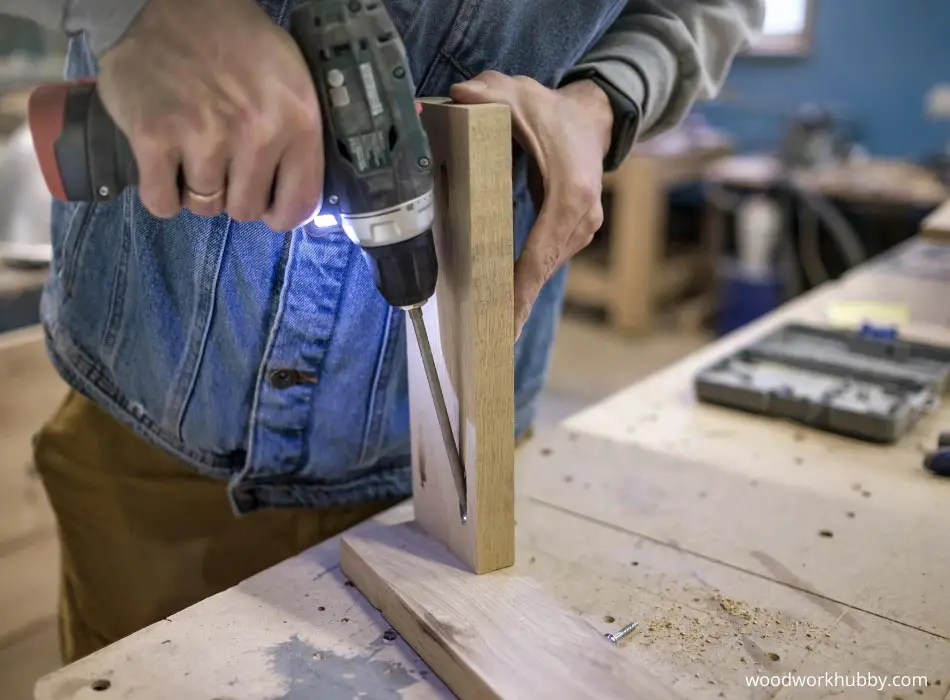Recently I had to knock up some frames for a home extension I am doing. I saw this topic come up a few times in my carpeting career so I decided to do an experiment on one of my small wall frames. Can you use pocket holes for framing?
Pocket holes can be used for timber framing of a wall providing the joint does not bear weight. They fix just as strong as nails although they are much slower to do. The type of wood, length of the joint screw, and the screw material dictate the joint’s longevity.
In this article, you will learn more about different types of framing and pocket hole joints’ compatibility with each variety. You will also discover whether these joints are reliable in the long term and what you can do to make sure they don’t come undone too early.
But first, let’s clarify why some resources seem to push pocket holes as frame-appropriate while others dismiss them as too weak to hold together any two panels together.
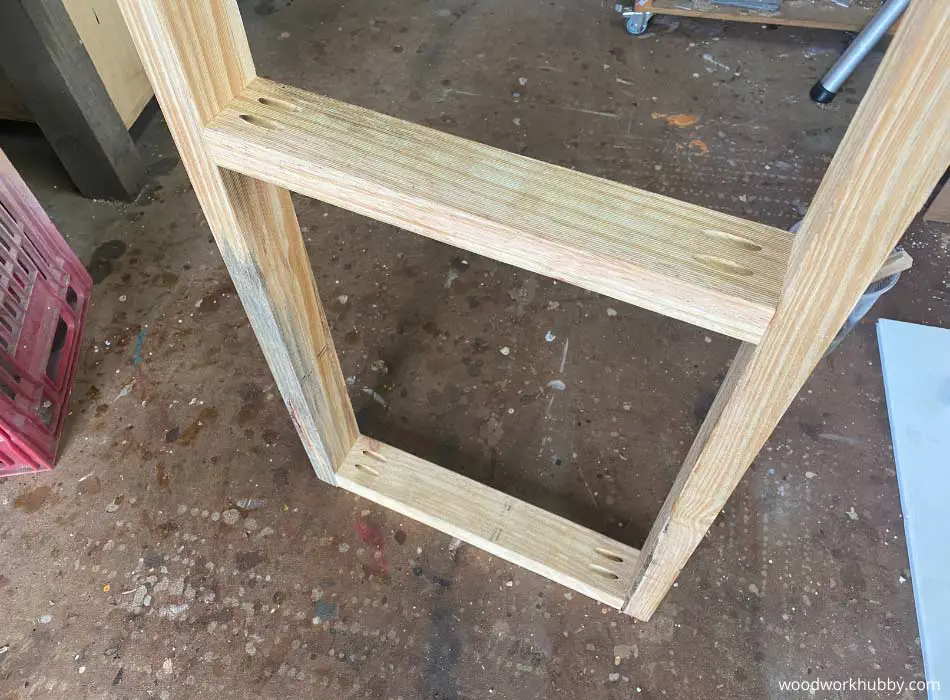
Framing and Pocket Holes – Can You Use Them?
Framing can refer to building large skeletal structures for a house or wall frames for drywall or MDF board partitions. It can also refer to creating wooden frames at home. For the latter, pocket hole joints can work.
If you want art or photo-framing, then you can use a pocket hole joint because you’ll replace frames in a decade. But given that wood framing of a house lasts 100 years and pocket hole joints can barely last a decade under constant pressure, you can see why pocket hole joinery isn’t home improvement experts’ go-to frame joint choice.
Be sure to check out my full write-up of why woodworkers hate pocket holes!
In my framing experiment, I found the pocket holes provided a strong fix although could be broken apart easily when pushed one way.
Smaller frame jobs can be held together with pocket hole screws, though. Despite not having as strong a weight-carrying capacity as mortise or tenon joints, pocket hole joints can carry a significant load in the short term. If the frame is not meant to last over a decade, it can be held together by a structural joint lodged in a pocket hole, which is great for art and photo frames.
Usually, pocket hole jig makers will lean towards exaggerating the use of pocket holes, while expert carpenters will dismiss them a little more than they deserve. Pocket hole screws have a utility that lies in the middle of these two extremes.
They aren’t strong enough to support bed frames, for example, but aren’t too weak to hold together an A4-size photo frame. With this context in mind, you can reconsider the initial question and get a more nuanced answer.
Can Pocket Screws Be Used for Framing?
Pocket screws can be used for framing wherever the frame is more decorative than load-bearing. Frames that decorate a shelf face or wall art might feature minute pocket hole screws, but frames that hold up drywall or a large cabinet require sturdier joinery.
Be Sure To Check Out My Other Handy Articles On Pocket Holes
Can you use pocket holes for framing?
Plenty of online resources tell their readers confidently that pocket holes are strong enough for framing because to them, the word framing means something else. In most home improvement and broader woodworking contexts, framing means building a skeletal structure for a large object.
The most common use of framing is when one uses multiple boards to construct a wall. The framing step sets the stage for the boards to fit in and form an opaque wall or interior cover.
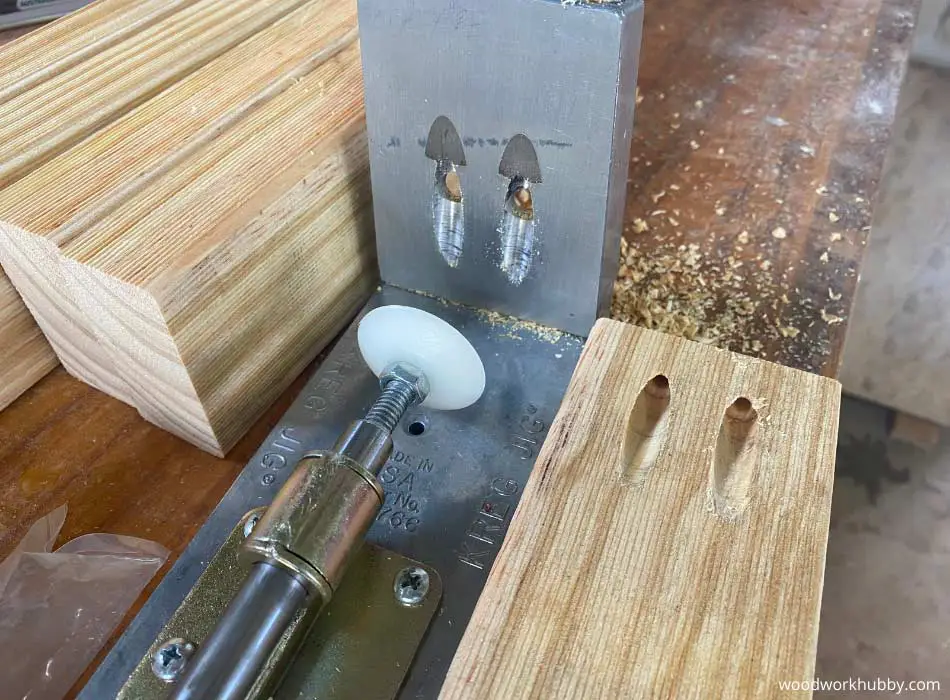
Such framing is different from framing in cabinet carpentry and fine art. In fine art, the word refers to placing art in a frame. These frames can be put together using pocket hole joinery because the art itself doesn’t weigh much.
In cabinet carpentry, the term can be erroneously used to refer to making a face frame for a project. Cabinet frames can also feature pocket hole joints unless the project is too large for the kind of screw you use.
While the word “framing” can refer to different things in different markets, pocket hole joinery has universal conditions of applicability. You should keep in mind the following when opting for a pocket hole joint:
- Pocket hole joints aren’t meant to carry weight and will come undone under pressure.
- A pocket hole joint’s strength depends on the screw used and the kind of wood it is applied to.
- One should never consider a pocket hole joint permanent.
The final point there leads us to the question one should ask before opting for pocket hole joints for any project: Am I willing to put up with the consequences of this joint being undone?
Pocket hole joints have impressive permanence for being impaled at an unstable angle and can outlast most projects’ shelf-life. That doesn’t change the fact that these joints are in the process of being undone when they’re under pressure.
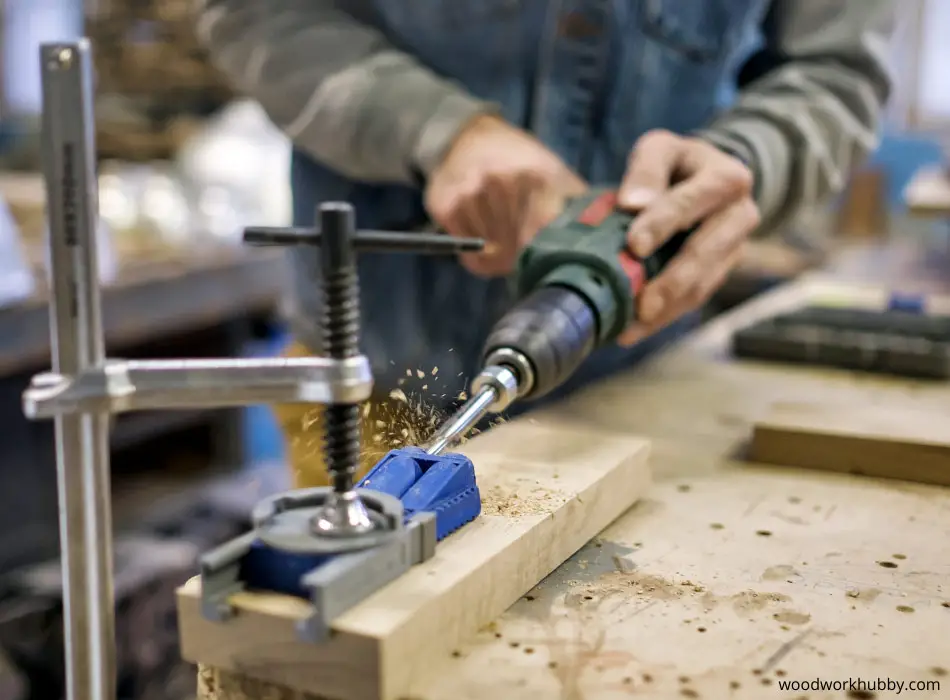
If it is a small project where you can use industrial staples to reinforce the joint or re-lodge a pocket screw without having to deal with a domino effect, then you should use pocket screws. But if one joint being undone leads to a large project (like drywall) falling apart, you should avoid pocket screws.
When Should You Not Use Pocket Holes?
Any project that has horizontal pressure can do better with pocket holes compared to a project that is under vertical pressure. While my post dedicated to pocket holes goes deeper into why you should avoid using pocking holes, this section looks at specific instances when you should stay away from pocket holes.
You should not use pocket holes when a project has to carry weight for an extended period, is a large-scale effort, or is a decor project where joints can be visible. In all three of those instances, the pocket hole joint has drawbacks that offset its advantage of being quick and easy to apply.
Projects That Carry Weight
Pocket hole screws might be able to hold together two pieces of wood, but any external pressure on the structure accelerates the undoing of these screws. External weight can undo the pocket hole joint immediately if the screw is small. In case the wood is weak, the screw bites into it when any weight is placed on it.
See my pictures of how close the screws are to the edge of the stud framing. I was easily able to break the noggin away because of the lack of wood left on the edge.
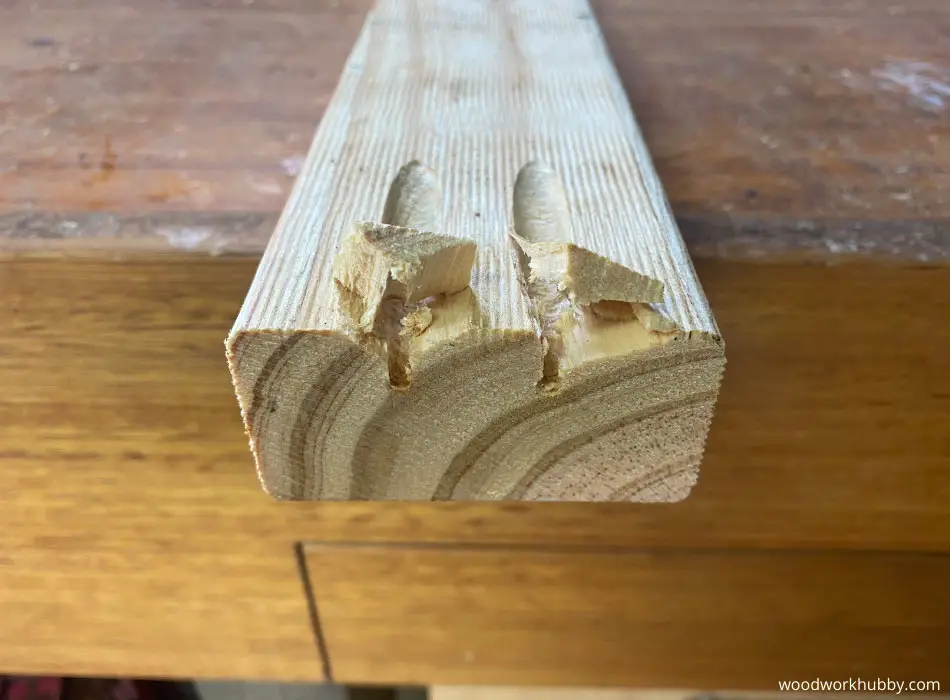
In some instances, the weight of the wood sheets used in the project can undermine the joints. Consequently, the weight of the overall structure must be considered crucial when assessing whether pocket hole joinery is appropriate for a project.
What this means for framing: If the type of frame you’re constructing will bear a load, then it should not rely on pocket hole joinery only. Clamps, pocket hole screws, and wood adhesive can sometimes collectively hold together a project. But in most cases, the frames held together by pocket hole joints are decorative only.
I would strongly advise using wood glue in pocket hole joints. Check out which glue is better – Titebond 2 or Titebond 3?
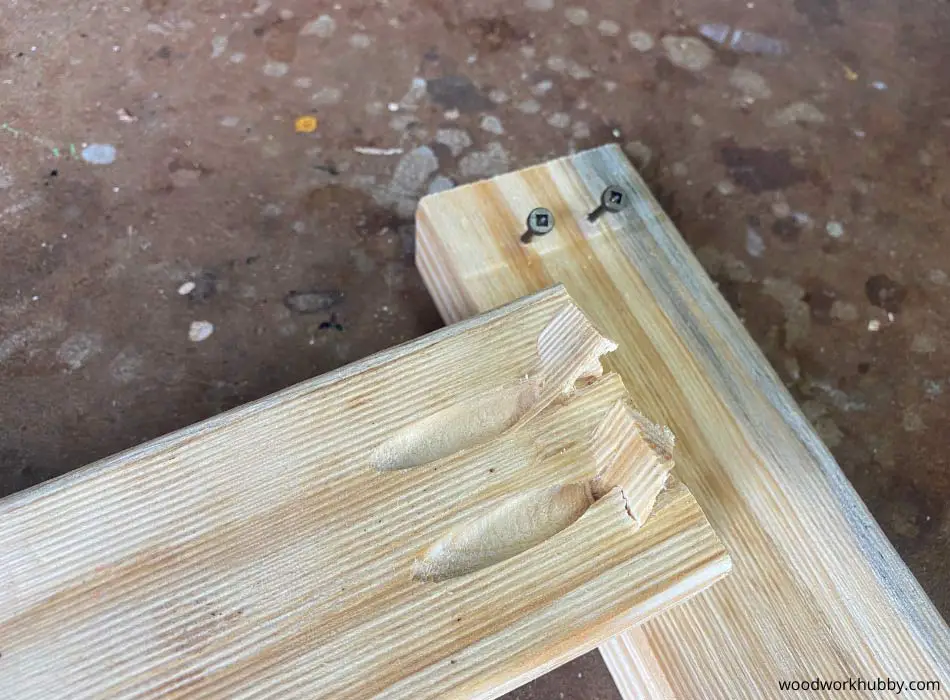
A Large-Scale Project
Pocket hole joinery is marketed as a quick and easy solution by the manufacturers of pocket hole jigs. I have enough experience in woodworking to know that much of what’s said by biased parties on the subject of pocket hole joinery is unsubstantiated. Pocket hole joints can be strong enough to carry some degree of occasional pressure.
However, having such a joint in a larger project is always risky because scale leads to constant pressure. Even an empty shelf exerts constant pressure on its lower joints when it reaches a massive scale.
Any type of project for which pocket holes work on a small scale cannot remain conducive to this type of joinery at a larger scale. With bigger projects, you also have more work to do when a joint comes undone.
What this means for framing: you can expect to use pocket hole joint for shelf and cabinet faces as long as no project is larger than a table surface. Once a project is large enough, its joints have a load-bearing responsibility that pocket hole screws cannot withstand over the long run.
Decor Projects With Visible Joints
Finally, you have to avoid pocket hole joinery where the joints are visible if the project has an aesthetic goal. In my experience, even projects that are meant to be functional and not decorative have an aesthetic element.
I used to make pocket holes all the time before learning advanced joinery, and even then, I could see that they weren’t visually appealing.
If the pocket hole screws can be covered up in a project, they should be used, but if they are visible because the sheets are too thin or the slabs are positioned in a very obvious way, you might need to use an alternative.
What this means for framing: While most art and photo frames are decorative, their joints aren’t visible if you apply them properly. The final section of this post covers how you can lodge pocket hole screws without making them visible or putting too much pressure on them.
Pocket Holes for Framing: When Is It Appropriate?
Reading this far, you can see that I am not biased in favor or against pocket hole joinery. Those who push such joints unconditionally peddle pocket hole jigs and those who dismiss these joints without assessing the context are angered by how easy pocket hole joinery is and how accessible it makes woodworking to newcomers. This blog isn’t about gate-keeping; it is about bridge-building.
Pocket holes aren’t appropriate for house framing but are acceptable (and even recommended) for framing art, photos, and posters. The table below shows when pocket hole joinery is appropriate for framing.
| Framing Category | Pocket Hole Compatibility | Context |
|---|---|---|
| House structure | Incompatible | Only use in small frames with glue |
| Wall framing | Partially compatible | For light-weight panel frames |
| Bed frames | Incompatible | In all projects |
| Photo/Art frames | Compatible | In most frames, including shelf-top frames, hanging art frames, and standing frames. |
| Face frames | Partially compatible | Small to medium-scale shelf and cabinet face frames. |
| Plywood frames (plywood edging) | Compatible | In most plywood edging |
Pocket Holes in Melamine – I wrote all about this here.
How To Use Pocket Holes For Framing
Now that we’ve separated the type of framing that isn’t conducive to pocket hole joinery, we can go over how you can achieve the best adhesion from a pocket hole joint in the appropriate frames.
Make Sure the Parallel Panel Lengths Match
Most frames will be rectangular though some might be square. In either case, you want to avoid parallel length mismatches as they weaken the tautness of the frame.
The length of the two parallel panels must match. In a square frame, all four panels should have the same length. In a rectangular frame, two shorter panels must match in length, and so should the two longer ones.
Use Clamps or Wood Adhesive
Aside from having the perfect height match to ensure frame tightness, you should use additional adhesion measures. In canvas frames that feature pocket holes, industrial staplers are used for added strength.
In most other frames, you should use a combination of wood glue and clamps, where the former is best for small photo frames and the latter for larger shelf face frames.
Use the Appropriate Screw
A pocket hole joint is strong as the screw used in it. I prefer longer screws for larger projects and structural ones regardless of the kind of frame I’m putting together. But this has more to do with the ease of availability. If you opt for a lag screw, you should make sure it works for the kind of project you’re interested in.
Be sure to look into using a pilot hole. Check out my article here showing what is the best size pilot hole!
Are Kreg Screws Structural?
Kreg screws are not structural though they are designed to work well in pocket hole joints on slim frames. They are sturdy and feature a flat head that sits at the base of a pocket hole. If the wood panels are thicker, then you should opt for a long structural screw instead of a Kreg screw.
Final Thoughts – Can You Use Pocket Holes In Framing?
Pocket hole joints work in framing anything that doesn’t put extra weight on the frame. For example – I would use pocket holes on internal joinery frames where the screws are not visible. I would not use pocket holes in wall framing.
Wherever the frame’s job is to look good without providing any support, you can confidently opt for pocket hole screws. In some cases, there might be an additional load on a frame, for which you should add clamps or wood adhesive to your joinery to provide further support.
For more woodworking tips, be sure to check out my other articles at woodworkhubby.com

